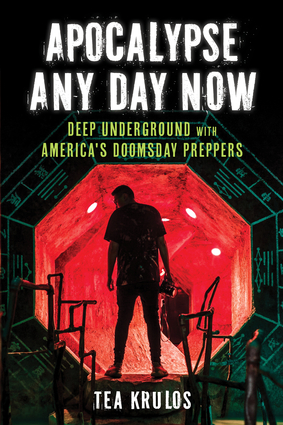
Sign up today...
for featured titles, special offers, bestsellers, and more, in your inbox!
 |
The end is near. A slogan once reserved for the cardboard signs of street corner seers has developed into an everyday facet of mainstream life. Not since the dawn of time has the end of time enjoyed such a ubiquitous presence in human society. The apocalypse is no longer the sole property of religious zealots. Today, everyone from climatologists to political scientists, doomsday preppers to survivalists and anybody with a Netflix account can’t escape the omnipresence of the apocalypse.
In Apocalypse Any Day Now: Deep Underground with America’s Doomsday Preppers (Chicago Review Press), journalist Tea Krulos explores the modern fascination with the end of the world, documenting his experiences in the growing subculture surrounding the apocalypse.
We caught up with Tea to discuss how writing and researching his book has influenced his experience navigating life during the COVID-19 pandemic. If you only read one article before the world ends, make it this one.
I started making a bug out bag, but didn’t finish, thinking I’d get to it later, but then “later” happened. I don’t think it’s foolish or crazy to be prepared. This pandemic, with most states having a stay-at-home order is a great example of why. I think it’s wise to have a stockpile of stuff in the case that an emergency leaves you stuck at home.
The thing that appealed to me about preppers was the idea of creating a safety net for yourself and learning survival skills. We’re so reliant on technology, but what if technology completely crashes? A lot of people don’t know even the most basic survival skills. I really enjoyed camping out with Zombie Squad and learning new skills while working on Apocalypse Any Day Now. On the other hand, the thing that turned me off about some prepping groups was that there was a lot of paranoia and a lack of community, an “us, the prepared vs everyone else” attitude. There’s a line you have to navigate between a healthy approach and an unhealthy obsession.
I think so, yes. All the images we’ve seen during this pandemic of people quickly grabbing up all the toilet paper and bottled water in stores, the makeshift medical tents in Central Park and the hospital ships, the lines of people in facemasks, and the daily death counts, are going to make a lot of people think that prepping isn’t a crazy hobby like they thought. Prepping was already a big industry but I think you’ll see a lot of new preppers, especially with the threat of pandemics like this reoccurring.
I think what we’re seeing is that a pandemic can be damaging to society on a number of levels. One thing that I learned is that an apocalyptic setting will probably not just be caused by one event, but a chain reaction of events. So, for example, climate change might help spread viruses, causing a pandemic. The threat of the pandemic is not just the people dying from the virus, but the other repercussions, like millions of people being unemployed. If people believe they are in desperate times, you could see an increase in looting and robbing, which could be answered with a more totalitarian response from the government, which will be met with rebellion. One bad thing leads to the next.
The Bulletin of the Atomic Scientists was formed after World War II to monitor emerging threats like nuclear proliferation, and later artificial intelligence, climate change, and bioweapons. The “Doomsday Clock” is a metaphor they use to illustrate how close we are to “Midnight,” which symbolizes a nuclear annihilation or similar catastrophic event. In January 2020, they announced the Doomsday Clock was at 90 seconds to midnight, the closest it’s ever been since the clock was created in 1947. Some of the reasons– failure to address climate change, nukes, dismissal of facts as “fake news,” and other concerns.
People have been pointing to psychic Sylvia Browne’s 2008 book End of Days, which predicted that “in about 2020” a “pneumonia-like illness will spread throughout the globe.” Personally, I don’t take much stock in what she has said. In the same book she also said that the common cold would be cured by 2010 and that we’d all have robot housekeepers by 2015, among many other failed predictions, so I’m going to chalk Browne’s prediction as a hit in a long list of misses. Even a broken clock is right twice a day.
Leave a Reply